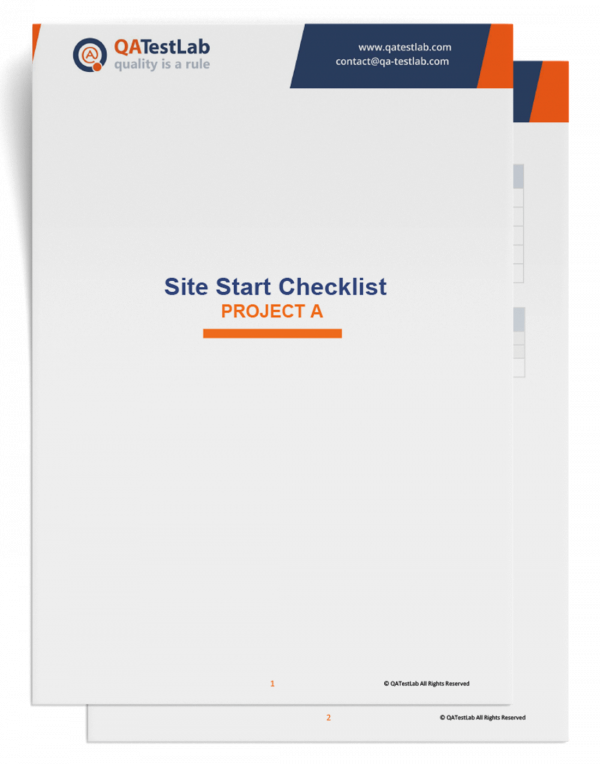Site Start Checklist
Here we offer the list of most useful checks and actions to be done before the site goes live (and some after it has already started).
Before starting
Content and style
- Typography
- Correct symbols. Put down the correct symbols such as dash, quotation marks and apostrophes, depending on the language of the site
- Hyphenation. Put down non-breaking spaces between initials, dashes, before the last words
- For the English: Ligatures. Put down ligatures in the headers, if needed
- Carefully read the text and check spelling
- The connectedness of the texts
- Check the register in the important texts and headlines
- Provide a single text style
- The unity of repetitive phrases (i.e. "Learn more", "Read more», «N comments", etc.)
- Punctuation in lists (e.g. if the list item ends with a point then the following paragraph should begin with an uppercase letter and vice versa for the semicolon)
- Check if there are no hardcoded links to dev-server
- Check of there is no test content on the site
- Check the printed versions of important pages
- Check the RSS feed and the displaying of content in Google Reader
- In the case of redesign or modification of the information, architecture check if there are redirects from the old URL to the new
- Check the hidden text (i.e., alt / title attributes of HTML tags, text in JavaScript functions)
Standards and Validation
- Accessibility for people with disabilities (check if everything is ok with the perception of color, sound, site navigation and so on)
- HTML validation
- JavaScript validation
- CSS validation
Availability in search engines, SEO and statistics
- Page Titles are very important, make sure they make sense and contain important keywords
- Fill in the meta- tag description for important pages
- Bring links to the home page to a single view (i.e., to choose one thing from variations http://site.ru, http://www.site.ru, http://www.site.ru/index.html)
- Guarantee the preceding 6 points by redirecting to the selected version (e.g. redirect from http://www.site.ru/ * to http://site.ru/ *)
- Ensure in semantically competent use of HTML tags (<h1>, <h2>, ... etc.)
- Check for important keywords in the content
- Bring references to a readable form (e.g. http://site.ru/blog/how-to-make-coffee, http://site.ru/user/nastya, etc.)
- Add Google Analytics, FeedBurner, and / or other systems of statistics measurement
- Create XML Sitemap
- Add this site to Google Webmaster Tools
- Check all ordered / special / complex functionality
- Check the search work (including relevance)
- Check the site work in different browsers (Internet Explorer, Firefox, Opera, Safari, Chrome etc.), versions (6, 7, 2.2, 3.1 etc.) and platforms (Windows, OSX, Linux)
- Check the view of the site at different screen resolutions (1280 × 1024, 1024 × 768 1920 × 1200 800 × 600 ...)
- Test all forms (contact, comments, feedback ...), add the captcha or other protection
- Check out all e-mail templates
- To test the site’s capacity for work with JavaScript, Flash, and other components turned off
- Check the availability of external links
Safety / Risk
- Configure scheduled backups, and test the restored one
- Check whether the visitors have access to the service/secret/private pages
- Close access to the service/secret / private parts of this site for the search engines using robots.txt
- Cut off the output of errors on the screen
- Check the amount of available disk space and calculate how much it will suffice
- Run a regular procedure for the crown (for most CMS)
- Configure email / SMS notification of inoperable site / server
Performance
- Conduct load testing
- Optimize the images / graphics
- Check and implement caching where it is necessary
- Check the overall size/speed of loading pages
- Minimize / compress static (JavaScript / HTML / CSS)
- Optimize CSS: a short path to the images, use the "cascading" basics of styles, etc.
- Check the availability of indexes in the database tables
- Check the other performance settings at all levels (server, database, CMS, etc.)
- Enable logging of errors/performance on the server.
The final touches
- Create your pages 404/403
- Create a page "Site is under maintenance"
- Create a favicon.
After starting
Marketing
- Add this site to social media: Twitter, VKontakte, LinkedIn, Facebook, etc.
- Add this site to search engines.
- Customize PPC / Google Adwords (if required).
- Check the formatting of the site in search results of search engines.
Other
- Monitor feedback (straight from the site, social media, Google, etc.)
- Catch possible statistics problems with some sections/pages of the site.
- Update the content.

